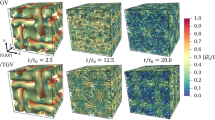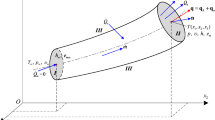Abstract
THE theory of the turbulent transfer of heat in the atmosphere, based on the concept of the mixing length, was introduced by G. I. Taylor1 in 1915. Modified by D. Brunt2 to be applicable to a compressible atmosphere, the theory requires that the flow of heat is in the direction of the gradient of potential temperature, and thus is normally downward. From these treatments a close analogy can be drawn between molecular transfer and the larger scale of eddy transfer.
This is a preview of subscription content, access via your institution
Access options
Subscribe to this journal
Receive 51 print issues and online access
$199.00 per year
only $3.90 per issue
Buy this article
- Purchase on SpringerLink
- Instant access to full article PDF
Prices may be subject to local taxes which are calculated during checkout
Similar content being viewed by others
References
Taylor, G. I., Phil. Trans. Roy. Soc., A, 215 (1915).
Brunt, D., Proc. Roy. Soc., A, 124 (1929).
Author information
Authors and Affiliations
Rights and permissions
About this article
Cite this article
PRIESTLEY, C., SWINBANK, W. Transport of Heat and other Properties by Atmospheric Turbulence. Nature 159, 61 (1947). https://doi.org/10.1038/159061b0
Issue date:
DOI: https://doi.org/10.1038/159061b0



